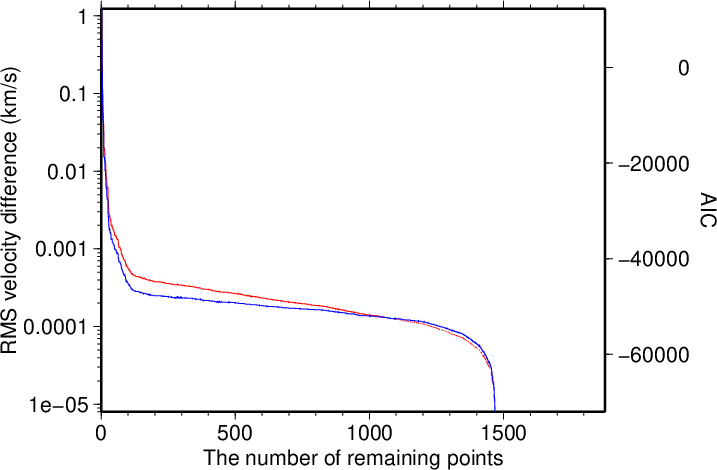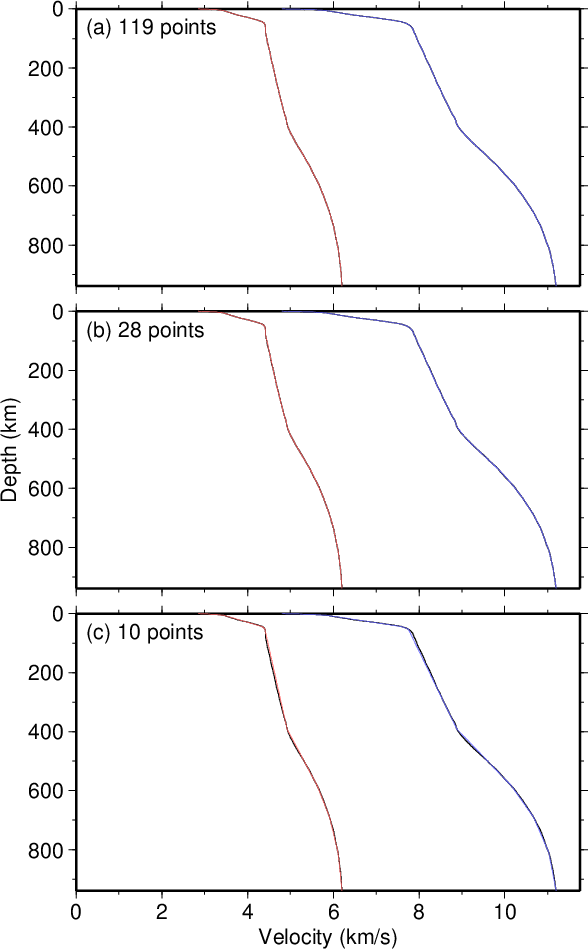| unit | 戻り値の単位。以下の選択肢が利用できる。 The unit of the return value, which can be one of the followings.
|
| 戻り値のメンバ Member of the return value |
値 Value |
| N | 28 |
| depths | 28個の速度定義点の深さを浅い方から順に並べた配列。 An array composed of the depths of 28 velocity definition points, sorted from shallower to deeper. |
| velocities | 28個の速度定義点でのP波速度を浅い方から順に並べた配列。 An array composed of the P-wave velocities of 28 velocity definition points, sorted from shallower to deeper. |
| slope_shallow | 最も浅い2つの速度定義点間のP波速度勾配。 The P-wave velocity slope between the two shallowest velocity definition points. |
| slope_deep | 最も深い2つの速度定義点間のP波速度勾配。 The P-wave velocity slope between the two deepest velocity definition points. |
| 深さ(km) Depth (km) |
P波速度(km/s) P-wave velocity (km/s) |
S波速度(km/s) S-wave velocity (km/s) |
| 0.0 | 4.800 | 2.844 |
| 1.5 | 5.220 | 3.088 |
| 2.5 | 5.450 | 3.221 |
| 4.0 | 5.720 | 3.375 |
| 5.0 | 5.820 | 3.431 |
| 15.0 | 6.220 | 3.634 |
| 22.0 | 6.544 | 3.803 |
| 34.0 | 7.188 | 4.140 |
| 41.0 | 7.494 | 4.294 |
| 44.0 | 7.598 | 4.344 |
| 48.0 | 7.688 | 4.382 |
| 52.5 | 7.750 | 4.403 |
| 65.0 | 7.845 | 4.419 |
| 80.5 | 7.891 | 4.420 |
| 252.5 | 8.423 | 4.679 |
| 349.5 | 8.749 | 4.847 |
| 370.5 | 8.835 | 4.895 |
| 391.5 | 8.885 | 4.922 |
| 420.0 | 9.029 | 5.002 |
| 447.5 | 9.210 | 5.102 |
| 535.0 | 9.849 | 5.457 |
| 585.0 | 10.164 | 5.631 |
| 630.5 | 10.405 | 5.765 |
| 690.0 | 10.673 | 5.913 |
| 732.0 | 10.826 | 5.998 |
| 809.5 | 11.028 | 6.110 |
| 870.0 | 11.127 | 6.165 |
| 939.5 | 11.199 | 6.204 |

